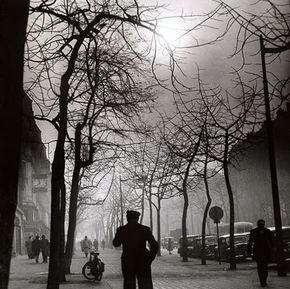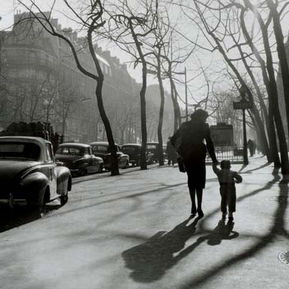FOTOTECA SIRACUSANA
PHOTOGALLERY - FOTOGRAFIA VINTAGE - BIBLIOTECA TEMATICA - CAMERA OSCURA B&W - DIDATTICA
SCRIPTPHOTOGRAPHY
Édith GÉRIN (F)

ÉDITH GÉRIN
Umanista sì, umanista no. Che importano i generi? Che importa classificare un fotografo sotto il capitolo di quello o quell’altro genere: un fotografo è un fotografo. Ma se è lo stesso fotografo a rifiutare l’etichetta di “fotografo umanista” noi non possiamo che rispettarne il desiderio. Édith Gérin (1910-1997) ha provato come ha potuto a smarcare il suo nome dai tentativi di etichettarne il lavoro. Eppure, essere accostati ai maestri della fotografia umanistica poteva riempire d’orgoglio chiunque. Non lei, che si diceva lontana dai lavori di Henri Cartier-Bresson, di Willy Ronis, di Édouard Boubat, di Eric Schwab, di Izis, di Robert Doisneau, di Sabine Weiss per sensibilità e obiettivi, nonostante “La photographie umaniste” avesse in copertina proprio una sua fotografia. Alla curiosità, al particolare, all’attimo e la poetica del momento decisivo Édith Gérin preferiva le impressioni, le suggestioni di una Parigi che dai ciottoli bagnati delle strade del Quartier Latin trasudava l’urgenza di recuperare se stessa dopo lo sfregio della guerra. E dalle brume parigine, da cui si lasciava assorbire per ricavarne impressioni veloci da preservare dalla corruzione dell’attimo, così come nei grandi cieli immanenti, Édith Gérin rivela d’essere prossima più alla lezione della pittura impressionista. È in quella direzione che guarda, e tra le impressioni fonderà uno stile impegnato ad assorbire ogni stilla di luce per riversarla addosso i suoi soggetti. Nel corpus centrale del suo lavoro, vediamo come i soggetti di Édith Gérin altro non siano che delle presenze che condividono il primato della rappresentazione con la città, fondando una equivalenza – qui la differenza con gli “umanisti” – tra l’uomo e la città. Nella “Le Passant du Pont des Arts”, forse la sua fotografia più celebre, l’uomo dal passo veloce è fermo nell’istante della sua “fusione” con la città: sebbene vi sia una naturale dimensione prospettica, essa è sistematicamente azzerata da una scala di grigi che lega tutto, che raggruppa tutto perché tutto sia in eguale misura organico al racconto: lo è la Senna, quasi nascosta dalla ringhiera metallica; lo è lo sfondo dell’ Île de la Cité; e ancor più lo è un cielo nervoso che rinuncia al ruolo di sfondo per diventare soggetto e ricopre ogni cosa. Ombre. Lunghissime e affilate. Ombre d’uomini e cose dipartono da un punto per incombere sull’inquadratura come irrinunciabile elemento di composizione. Gli stessi soggetti nelle fotografie di Édith Gérin spesso abdicano al ruolo descrittivo per essere ombre a loro volta; ombre che si confondono con altri elementi e che insieme sono chiamati a dialogare. Dai ciottoli come dai boulevards di una Parigi che non c’è più, Édith Gérin ha ricamato la sua trama, con una grazia poetica e dolente, fatta di impressioni che si imprimono nella memoria come i versi di una poesia che abbiamo amato. E lì sono destinati a restare: quando il cuore è negli occhi, accade questo.
Giuseppe Cicozzetti
foto Édith Gérin
Humanist yes, humanist no. What do genres matter? What does it matter to classify a photographer under the chapter of that or that other genre: a photographer is a photographer. But if it is the photographer himself who rejects the label of "humanist photographer" we can only respect his desire. Édith Gérin (1910-1997) tried how he managed to disentangle his name from attempts to label his work. Still, being close to the masters of humanistic photography could fill anyone with pride. Not her, who said she was far from the works of Henri Cartier-Bresson, Willy Ronis, Édouard Boubat, Eric Schwab, Izis, Robert Doisneau, Sabine Weiss for sensitivity and goals, despite the fact that "Humanist photography" had in cover just her own picture. To curiosity, to detail, to the moment and the poetics of the decisive moment Édith Gérin preferred the impressions, the suggestions of a Paris that exuded the urge to recover herself after the scarring of the war from the wet cobblestones of the streets of the Latin Quarter. And from the Parisian mists, from which she allowed herself to be absorbed to obtain quick impressions to preserve from the corruption of the moment, as well as in the great immanent skies, Édith Gérin reveals that she is closer to the lesson of Impressionist painting. She looks in that direction , and between the impressions he will merge a style committed to absorbing every drop of light to pour his subjects onto him. In the central corpus of his work, we see how Édith Gérin's subjects are nothing more than presences that share the primacy of representation with the city, founding an equivalence - here the difference with the "humanists" - between man and the city. In the "Le Passant du Pont des Arts", perhaps his most famous photograph, the man with the fast pace is firm in the moment of his "fusion" with the city: although there’s a natural perspective dimension, it’s systematically zeroed by a gray scale that binds everything, that groups everything together so that everything is equally organic to the story: the Seine is almost hidden by the metal railing; is the background of the Île de la Cité; and even more so is a nervous sky that renounces the role of background to become a subject and covers everything. Shadows. Very long and sharp. Shadows of men and things depart from a point to loom over the frame as an indispensable element of composition. The same subjects in Édith Gérin's photographs often abdicate the descriptive role to be shadows in turn; shadows that mingle with other elements and that together are called to dialogue. From the pebbles as from the boulevards of a Paris that no longer exists, Édith Gérin has embroidered her plot, with a poetic and painful grace, made of impressions that are imprinted in the memory like the verses of a poem that we loved. And there they are destined to remain: when the heart is in the eyes, this happens.
Giuseppe Cicozzetti
ph. Édith Gérin











